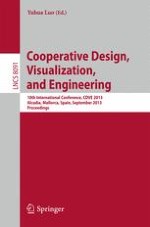This book constitutes the refereed proceedings of the 10th International Conference on Cooperative Design, Visualization, and Engineering, CDVE 2013, held in Palma de Mallorca, Spain, in September 2013. The 34 revised full papers presented were carefully reviewed and selected from numerous submissions. The papers cover all the topics of cooperative engineering, basic theories, methods and technologies that support CDVE, cooperative design, visualization and applications. There are special contributions dealing with the cooperative issues brought by the Internet of things - such as the situation in the ambient assisted living systems. Other papers in the volume cover a wide range of cooperative application topics such as cooperative e-learning, cooperative decision making and cooperative simulation etc.
